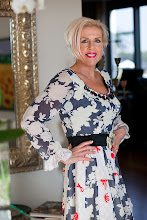Peter Frankopan, a Historian at Oxford University,
writing for Huffpost Culture, compares Bowie to a living saint: “I'll be packing off my students to see it - if
they can get tickets, that is,” he says, “as it is the perfect example for
anyone wanting to understand medieval religion. The record-breaking crowds that
will flock to see the show will be like pilgrims visiting a shrine of an
important saint: here is the outfit Bowie wore when he sang Starman on
Top of the Pops; there are the lyrics, written in his own hand, for Rebel
Rebel. There is the printed itinerary of the train journey across the eastern
US, with stop-offs to the end of the line before the rest of the trip was by
car and van. They are like relics belonging to a holy man, objects to be
admired.”
You have to be pretty saintly to stand in a queue
for an hour to see an exhibition - and
that was just on the preview day. But
it’s well worth it to see the costumes alone – many of them designed or
co-designed by Bowie himself.
The fashion legend and living curiosity that is David
Bowie started out as plain old David Jones in London’s Brixton. He passed his
11+ but, instead of going to grammar school, attended Bromley Technical High
School, where he specialized in music and art. He says that if he hadn’t become
a singer, he would like to have been a writer. The V and A’s Bowie Is exhibition
(in partnership with Gucci) is a testament to Bowie’s skill as a
multi-disciplinarian - as a lyricist, musician, artist and fashion designer.
Above all, it illustrates the extent of Bowie’s impact on style and culture –
an influence spanning over five decades.
Many of Bowie’s 1970s costumes were inspired by
the space travel that captured the popular imagination of the day – from Willy
Brown’s late 1970s jumpsuit with le Corbusier-inspired line drawings that Bowie
wore as Major Tom to the quilted two piece suit he performed Starman in (above), and set
designer Mark Ravitz’s avant garde outfit for the Man Who Sold the World.
But the inspiration for Bowie’s dress came from a
multitude of other sources too – including the film A Clockwork Orange, the glam
rock genre, edgy Weimar Republic cabaret, Japanese kabuki, German expressionist
films and Hindu style bindis (like the colourful third eye on the cover of
Aladdin Sane).
Standout items include a replica of the Ziggy
Stardust bodysuit designed by Bowie and Freddie Burretti, and an appliqued satin
cloak and platform boots by Kansai Yamamoto – not forgetting Yamamoto’s extraordinary
Tokyo bodysuit at the show's entrance (above top). Yamamoto famously declared that his clothing
suited Bowie because his designs could be worn by either sex. Curiously, the
Japanese words on Yamomoto’s cloak spell out David Bowie, but translate as,
‘one who spits out his words in a fiery manner.’
Other famous costumiers include Thierry Mugler, and
Natasha Korniloff - responsible for Bowie’s curious 1973 cobweb costume with
fake hands. The cobweb costume originally had a third hand, which grasped at
the crotch, but this was censored for an appearance on television - and gold
leggings were added to preserve decency. Korniloff also created Bowie’s naval
look (1978) and his famous Pierrot style costume (1980).
The late Ola Hudson, mother of Guns N Roses' Slash, was another regular contributor to what is now Bowie’s fashion archive
(and reputedly his lover too). Alison Chitty’s design
for Screaming Lord Byron (1984), Freddie Buretti’s Ice Blue Suit (below) for Life on
Mars (1972) and Ravitz’s ‘skirt suit and poodle’ for an appearance by Bowie on
Saturday Night Live are among the unique outfits. There’s a fab black suit with a frilled shirt by Georgio Armani
from the 1990 Sound and Vision tour, a blue silk suit by Hedi Slimane – and
accessories include a single dangly earring by Vivienne Westwood.
A wardrobe mood board (from 2003?) list Bowie’s school-boyishly svelte measurements: chest 34.5 inches, waist 26.5 inches
and neck size 14. Being so trim may well have contributed to Bowie’s longevity as
a performer and fashion icon.
From the mid ‘90s, Alexander McQueen was a
significant contributor to the Bowie wardrobe too. It’s a shame you can’t see
some of the fabrics more clearly, as parts of the exhibition
space are presented like a dimly lit music venue, but McQueen’s designs include
a number of frock coats, brocade jackets, a tyre-print suit and a Bowie’s
famous Union Jack coat for the Earthling album cover (co-designed with Bowie in
1997).
Finally, ShopCurious has some tips for visiting the show: Leave longer than you anticipate for a visit to this exhibition – especially if your car is parked on a meter. The headphones supplied to all visitors take a little getting used to – if you find yourself stuck with Gilbert and George, just press the magnifying glass symbol (seemed to work for me, anyway). Oh, and be prepared to queue.
Finally, ShopCurious has some tips for visiting the show: Leave longer than you anticipate for a visit to this exhibition – especially if your car is parked on a meter. The headphones supplied to all visitors take a little getting used to – if you find yourself stuck with Gilbert and George, just press the magnifying glass symbol (seemed to work for me, anyway). Oh, and be prepared to queue.












1 comment:
my word, his measurements are tiny!! my waist and chest are over a foot wider than his... feel fat now. This is an exhibition I'd really like to see - and also the pompeii one too, might have to see if I could fit in both in a proper one day cultureblitzkrieg
Post a Comment